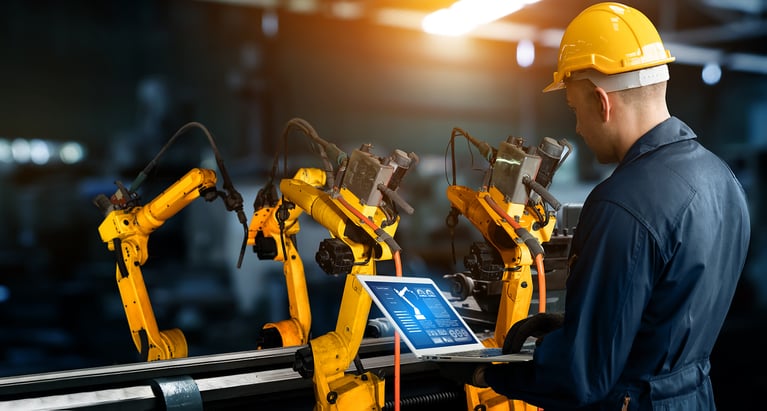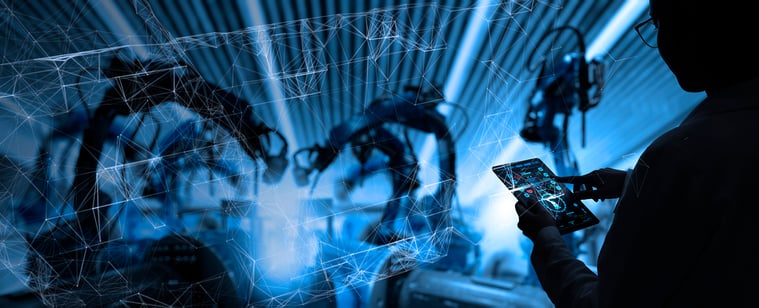In the past, many high-level decisions in the manufacturing sector were made based upon intuition, human intelligence, experience, or gut feeling. Today, as technology advances, many decisions are made based on information from online databases, statistical analysis, experiments, and other sources. The rise of artificial intelligence (AI) has been a major driver for this change, with manufacturers using AI to improve manufacturing methods and productivity. There are several ways that AI helps the manufacturing industry.
But first, what is an AI?
An artificial intelligence system, or AI, is a computer program that mimics human decision-making processes. It can be trained to make decisions on its own using data collected through sensors, cameras, microphones, GPS systems, etc., which may include images, videos, or audio recordings. For example, if you have a camera pointed at your production line, the AI could watch for patterns and anomalies in the movement of products on the factory floor.
The term “artificial intelligence” was coined by John McCarthy at Dartmouth College in 1956. He defined the concept as: “the science and engineering of making machines do things that would be considered intelligent if they were done by people.” This definition is still relevant today. (See reference URL below)
There are many types of AI.
Some are designed to perform specific tasks, such as image recognition, speech processing, natural language processing, pattern recognition, etc. Others are general purpose AIs that use these functions to solve problems.
In this blog post, I'm going to cover the benefits of AI in manufacturing.
What are the benefits of AI in the manufacturing process?
Increased productivity
With AI, manufacturers can significantly increase their productivity.
AI can scan a huge volume of manufacturing data - including scheduling, capacity planning, material requirements planning (MRP), quality control (QC), and component design - and intelligently suggest changes that will dramatically increase efficiency and production times.
For example, if a manufacturer has a new product coming out, it might want to add more workers to the production line to meet potential supply chain demand. But, without an AI solution, there's no way to know whether adding more workers will improve performance. An AI solution can analyze thousands of variables, including worker skill levels, training schedules, workflows, equipment availability, raw materials, supply chain constraints, predictive modeling and much more.
The result is a recommendation about how to best allocate resources to maximize output.

Improved safety
AI is already being used in a wide variety of ways to minimize risk in the workplace. It can identify unsafe processes and procedures, flag them for human review, and make suggestions for improvement.
For example, a robotic arm could detect when a product is about to fall off the conveyor belt. AI could then warn the operator who could stop the machine and prevent injury.
So, while we should always exercise caution when working with any new technology, AI can improve our ability to protect workers by increasing safety on the production floor.
Improved quality control
By intelligently analyzing the data from multiple sources, AI can detect flaws in products before a human ever notices them. It can also make intelligent suggestions on how to improve product quality. For example, if a certain component has been having trouble meeting specifications, the engineer might look at the data to see why this is happening. Then he/she can adjust the process to ensure that the problem doesn't continue. What does that mean to a manufacturer? Fewer rejects, fewer recalls, and lower warranty costs.
Reduced costs
In many cases, the implementation of AI solutions can save manufacturing company’s operations costs. By automating repetitive tasks and with AIs predictive maintenance, they can free up unnecessary cost overheads for operational improvement. As a result, that helps reduce the overall operations expenses.
Increased accuracy
An AI system can increase the accuracy of measurements. A factory worker might measure something incorrectly due to fatigue or lack of concentration. These mistakes could be small or large depending on what process is being carried out. But no matter how big or small these errors are, they all add up over time. However, if the measurement was taken using an AI system, manufacturers can achieve higher precision. This ensures consistency of product designs across the entire operation. Also, that means that the product meets the required specifications of the customer because it works properly.
 More efficient operations
More efficient operations
A typical industrial plant has many kinds of connected machines, making up complex networks, and each with its own unique set of parameters. In addition to the machine itself, there are also other factors that affect how well it works: raw materials, tools, energy sources, and human labor. AI can assist in finding the best combination of these resources to produce as many products as possible in the shortest and optimal time.
This process of optimizing production and its complex tasks is known as manufacturing optimization, which can now be done using AI. The end-result? More efficient production operation, which translates into fewer product recalls due to defective products, less wasted resources, and less downtime for businesses.
Faster decision-making
When faced with complex situations, humans tend to think about things slowly. As a result, this can slow down a production process.
By contrast, AI systems can quickly analyze data and draw conclusions based on historical data sets. For example, AI can help with logistics optimization for material requirements planning (MRP). MRP is the process of determining what materials are needed for a product, how much of each material should be ordered, and when it will arrive at the production site.
With more accurate predictions, manufacturing companies can place orders earlier and avoid delays.
Conclusion
The adoption of AI is not about replacing humans with robots. Rather, it is about improving the manufacturing process and increasing efficiency. With AI, manufacturers can streamline production operation, cut costs, and deliver high-quality products faster than ever before. AI is already revolutionizing manufacturing around the world. And it is only going to get better.
Reference:
- https://courses.cs.washington.edu/courses/csep590/06au/projects/history-ai.pdf
*******************
To learn how Radwell International can support your manufacturing operation

